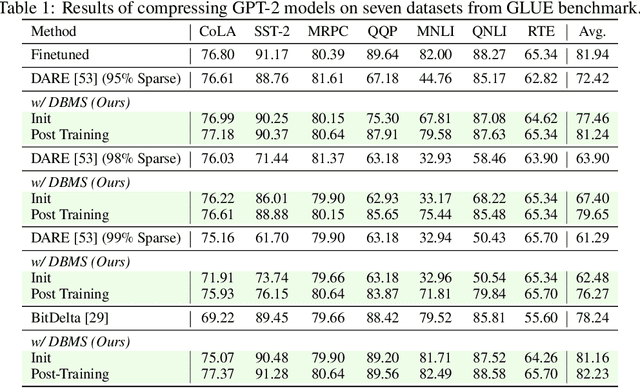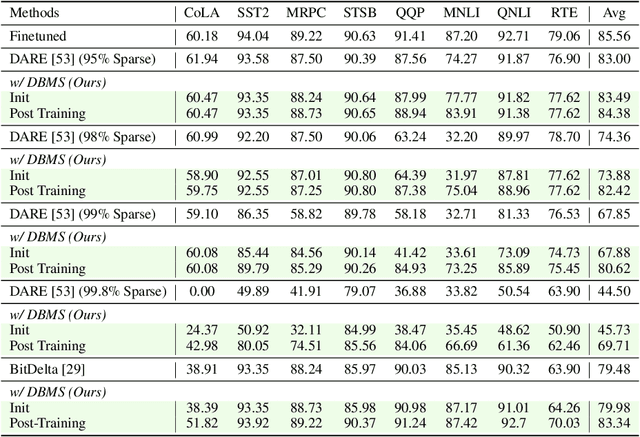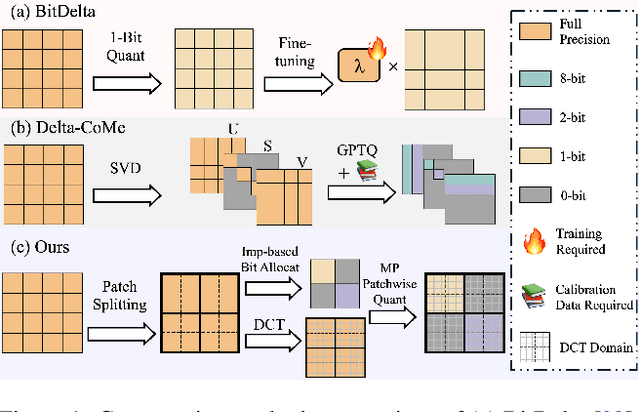Shenghe Zheng
Decouple and Orthogonalize: A Data-Free Framework for LoRA Merging
May 21, 2025Abstract:With more open-source models available for diverse tasks, model merging has gained attention by combining models into one, reducing training, storage, and inference costs. Current research mainly focuses on model merging for full fine-tuning, overlooking the popular LoRA. However, our empirical analysis reveals that: a) existing merging methods designed for full fine-tuning perform poorly on LoRA; b) LoRA modules show much larger parameter magnitude variance than full fine-tuned weights; c) greater parameter magnitude variance correlates with worse merging performance. Considering that large magnitude variances cause deviations in the distribution of the merged parameters, resulting in information loss and performance degradation, we propose a Decoupled and Orthogonal merging approach(DO-Merging). By separating parameters into magnitude and direction components and merging them independently, we reduce the impact of magnitude differences on the directional alignment of the merged models, thereby preserving task information. Furthermore, we introduce a data-free, layer-wise gradient descent method with orthogonal constraints to mitigate interference during the merging of direction components. We provide theoretical guarantees for both the decoupling and orthogonal components. And we validate through extensive experiments across vision, language, and multi-modal domains that our proposed DO-Merging can achieve significantly higher performance than existing merging methods at a minimal cost. Notably, each component can be flexibly integrated with existing methods, offering near free-lunch improvements across tasks.
Dynamic Base model Shift for Delta Compression
May 16, 2025



Abstract:Transformer-based models with the pretrain-finetune paradigm bring about significant progress, along with the heavy storage and deployment costs of finetuned models on multiple tasks. Delta compression attempts to lower the costs by reducing the redundancy of delta parameters (i.e., the difference between the finetuned and pre-trained model weights) through pruning or quantization. However, existing methods by default employ the pretrained model as the base model and compress the delta parameters for every task, which may causes significant performance degradation, especially when the compression rate is extremely high. To tackle this issue, we investigate the impact of different base models on the performance of delta compression and find that the pre-trained base model can hardly be optimal. To this end, we propose Dynamic Base Model Shift (DBMS), which dynamically adapts the base model to the target task before performing delta compression. Specifically, we adjust two parameters, which respectively determine the magnitude of the base model shift and the overall scale of delta compression, to boost the compression performance on each task. Through low-cost learning of these two parameters, our DBMS can maintain most of the finetuned model's performance even under an extremely high compression ratio setting, significantly surpassing existing methods. Moreover, our DBMS is orthogonal and can be integrated with a variety of other methods, and it has been evaluated across different types of models including language, vision transformer, and multi-modal models.
Seeing Delta Parameters as JPEG Images: Data-Free Delta Compression with Discrete Cosine Transform
Mar 09, 2025



Abstract:With transformer-based models and the pretrain-finetune paradigm becoming mainstream, the high storage and deployment costs of individual finetuned models on multiple tasks pose critical challenges. Delta compression attempts to lower the costs by reducing the redundancy of delta parameters (i.e., the difference between the finetuned and pre-trained model weights). However, existing methods usually face problems including data accessibility and training requirements. To tackle this issue, we introduce Delta-DCT, the first data-free delta compression method inspired by classic JPEG image compression, leveraging the Discrete Cosine Transform (DCT). We first (a) group delta parameters within a layer into patches. Then we (b) assess the importance of each patch and allocate them with different quantization bit-widths. Afterwards, we (c) convert these patches to the DCT domain and conduct quantization to each patch based on the allocated bit-width. The proposed Delta-DCT does not require any training or data calibration, while achieving performance comparable to or even surpassing original finetuned models under 1-bit equivalent delta compression ratios on different kinds of models including: (1) recently-released LLMs of different sizes from 7B to 13B, (2) relatively smaller language models including RoBERTa and T5 models, (3) variants of vision transformer models, and (4) multi-modal BEiT-3 models.
FREE-Merging: Fourier Transform for Model Merging with Lightweight Experts
Nov 25, 2024



Abstract:In the current era of rapid expansion in model scale, there is an increasing availability of open-source model weights for various tasks. However, the capabilities of a single fine-tuned model often fall short of meeting diverse deployment needs. Model merging has thus emerged as a widely focused method for efficiently building a single model tailored for multiple tasks combined from existing models. Nevertheless, existing model merging methods face challenging trade-offs between performance and deployment costs, primarily due to task conflicts within the merged network. Our analysis of neural networks reveals that some task-specific information introduced by fine-tuning minimally enhances performance but heavily impacts generalization, leading to task conflicts. To mitigate the impact of this information, we propose FR-Merging, an innovative method that leverages frequency domain information to efficiently filter harmful specialized information, thereby minimizing the impact of task conflicts on the backbone with minimal cost. Since performance loss is inevitable with cost-free merging methods, we introduce a lightweight task-specific expert that can be dynamically integrated during inference to compensate for information loss. This framework, FREE-Merging (FR-Merging with lightweight experts), strikes a balanced trade-off between training cost, inference speed, storage requirements, and performance. We demonstrate the effectiveness of both FR-Merging and FREE-Merging on multiple tasks across CV, NLP, and Multi-Modal domains and show that they can be flexibly adapted to meet specific needs.
IntraMix: Intra-Class Mixup Generation for Accurate Labels and Neighbors
May 02, 2024



Abstract:Graph Neural Networks (GNNs) demonstrate excellent performance on graphs, with their core idea about aggregating neighborhood information and learning from labels. However, the prevailing challenges in most graph datasets are twofold of Insufficient High-Quality Labels and Lack of Neighborhoods, resulting in weak GNNs. Existing data augmentation methods designed to address these two issues often tackle only one. They may either require extensive training of generators, rely on overly simplistic strategies, or demand substantial prior knowledge, leading to suboptimal generalization abilities. To simultaneously address both of these two challenges, we propose an elegant method called IntraMix. IntraMix innovatively employs Mixup among low-quality labeled data of the same class, generating high-quality labeled data at minimal cost. Additionally, it establishes neighborhoods for the generated data by connecting them with data from the same class with high confidence, thereby enriching the neighborhoods of graphs. IntraMix efficiently tackles both challenges faced by graphs and challenges the prior notion of the limited effectiveness of Mixup in node classification. IntraMix serves as a universal framework that can be readily applied to all GNNs. Extensive experiments demonstrate the effectiveness of IntraMix across various GNNs and datasets.
DCLP: Neural Architecture Predictor with Curriculum Contrastive Learning
Feb 25, 2023Abstract:Neural predictors currently show great potential in the performance evaluation phase of neural architecture search (NAS). Despite their efficiency in the evaluation process, it is challenging to train the predictor with fewer architecture evaluations for efficient NAS. However, most of the current approaches are more concerned with improving the structure of the predictor to solve this problem, while the full use of the information contained in unlabeled data is less explored. To address this issue, we introduce a contrastive learning framework with curriculum learning guidance for the neural predictor called DCLP. To be specific, we develop a plan for the training order of positive samples during pre-training through the proposed difficulty measurer and training scheduler, and utilize the contrastive learner to learn representations of data. Compared with existing predictors, we experimentally demonstrate that DCLP has high accuracy and efficiency, and also shows an encouraging ability to discover superior architectures in multiple search spaces when combined with search strategies.
 Add to Chrome
Add to Chrome Add to Firefox
Add to Firefox Add to Edge
Add to Edge